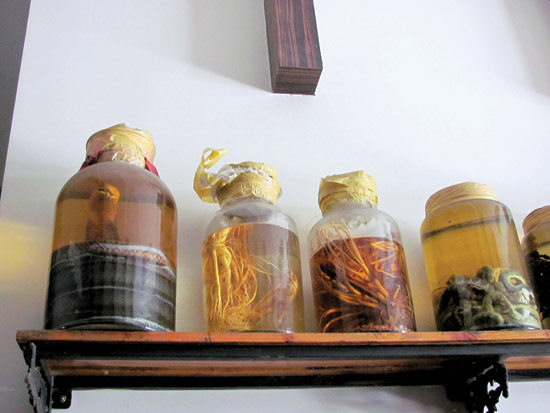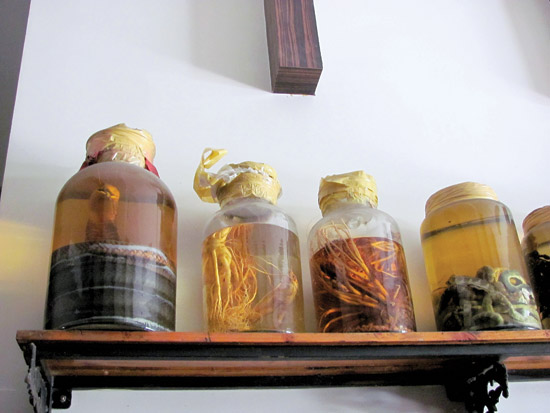(No.3, Vol.2 Mar 2012 Vietnam Heritage Magazine)
Trang advised we leave our motorbikes at the park and take a taxi in order to look more professional. We were checking on a case in Danang, in Central Vietnam, early one morning last April. It had been reported to the Forest Protection Department (FPD) a year before, but nothing had happened. We were visiting Vinh Hi restaurant at 50 Nguyen Trai, which sold wild meat. The plan was to sit in the restaurant and see what was on the menu, to try to establish if there were any live animals on-site or readily available.
‘But you have to keep calm’, Trang, a research officer from Education for Nature Vietnam (ENV), said, knowing how strongly I can react. I abhor cruelty to animals and have a reputation of leaping to their defence – usually to the great bemusement of the perpetrator.
Trang said it was a big advantage to have a foreigner on board in such investigations, because they could take photographs without arousing suspicion. Our cover story was that I was from a group of a dozen tourists and looking for a typical Asian restaurant and wanting to buy some special items.
I had a hidden recorder.
From the outside, the establishment looked small but the entrance stretched back a long way, leading to a large restaurant. On a high shelf were 15 large glass jars full of rice wine. In the centre was a tall, gourd-shaped ceramic jar. Most of the glass jars also contained snakes or tokay geckos. Each of the end ones held a huge coiled cobra. The most chilling was a little leopard cat (Prionailurus bengalensis), its beautiful striped face lifeless, in with a snake. Some jars held enormous ginseng roots, others white fungi. One was half-full with mealworms and another with sea urchins.

It was not the first time I had seen such sights. Snake and scorpion wine are a specialty in Laos. My acupuncturist in Danang had a collection on display until I reported him. And once I saw a huge cobra stewing in a jar of wine at a house I visited in the rural north. I was also to see a much larger collection of horrors in a small grocery shop, Ong Gia, in Yen Bai St, where half the space was devoted to wildlife. The elderly man looked at me with real hostility when I walked in, not even a smile or hello, so I didn’t dare take photos. Shelves floor to ceiling held snake-wine jars. There were three stuffed turtles on the wall and stuffed pangolins and a civet in a glass case – all endangered species, protected by law.
Using the bodies or body parts of certain species as medicine, a tradition learned long ago from the Chinese, is a major factor in fuelling the wildlife trade. Principally, snakes, geckos, lizards, turtles, monkeys, tigers and bears are used. Apparently the medicine is most efficacious if the animal is dropped in alive, expending its life force into the wine. It is taken for many kinds of ailments, or as a tonic, but men in particular drink it for libido and out of bravado. Although the tradition has existed for centuries in Asia, trade has grown at an exponential rate with the growth of tourism. In recent years, western backpackers have also got in on the act. A certain hostel in Hanoi promotes tours to ‘Snake Village,’ where foreigners can indulge in exotic barbaric acts – like drinking rice wine with a still-beating cobra’s heart. Such adventurers are only exacerbating the already dire situation for Vietnam’s wildlife and encouraging violation of wildlife protection laws.*
Vinh Hi’s owner came out to greet us before I had a chance to take photos. Trang gave him the story. He responded with some information and prices, but seemed quite nervous. I stood close by recording the conversation. Then a woman came out too, who seemed even more edgy. The owner said he only sold large jars – about 10 million dongs ($500) for the one with the leopard cat or the snakes. The tokay gecko wine was 3 million ($150).
‘Anyway, there is no point in selling small jars (as souvenirs,) because you cannot see the animal,’ he said.
After we’d got some information, I took a couple of photos of the jars, but both the man and his wife leapt forward, waving their arms, shouting, ‘No! No!’
We had got our evidence, but we had to wait a while for another taxi outside.
‘They’re a bit nervous, eh?’ I said.
‘Yes, of course! The FPD has been there many times – but maybe they have a special relationship.’
‘So don’t they sell wild meat?’
‘Yes, they have it. Porcupine, civet or wild pig . . . maybe more . . . He said, whenever you bring your friends to eat here, they will serve the wine.’
‘I’d thought we would sit in the restaurant and I could ask questions, but they’re too nervous, yeah?’
‘Maybe he remembered me, because I have been here two or three times already, with two or three cover stories!’
Trang is a master of disguise. A recent graduate, sometimes she plays the naïve student, other times she dresses and makes herself up like a serious businesswoman. She assures me, with obvious delight, that they don’t recognize her but she always knows them.
We were still waiting for the taxi and the owner had retreated back inside, so I ventured more photos, but their yappy dog alerted them and the woman came running out, shouting, ‘No, no!’ again.
In the taxi on the way back to the park where our bikes were, I expressed my distaste at seeing the leopard cat steeped in wine with the snake. Perhaps I was most affected by that animal because my own cat had ‘disappeared’ just two weeks before, and I know the cruel way a cat (‘little tiger’) is killed for meat.
‘Damn! I wish I’d got a picture of it!’
‘Yes, I know, but those are simple things in the front. If you could go upstairs, you could see many bears.’
‘What do you mean?’
I flashed on a whole bear marinating in a tank of alcohol, as a friend had been horrified to see in a Hanoi restaurant.
‘They have four bears in cages, in the dark – to take the bile. My colleague saw them last year, but the FPD cannot go up there, as there is not enough evidence.’
Strange. They had plenty of photographic evidence of other violations there, but had not taken any action.
Traditional Asian medicine uses bear bile, bear-bile wine or gall bladders to treat a variety of ailments, including arthritis, epilepsy, muscle pain, bruises, sore throats, hair loss and haemorrhoids or to ‘clear’ the liver. However, several other herbal remedies are equally effective.
Trang later told me there were at least two other places in Danang where bears were kept in this condition for bile-extraction, but the FPD ‘doesn’t believe’ ENV, even when a sign outside advertises the sale of bile. Trang said even the army had captive bears in Bach Dang St. How did she know? She had been there and asked about buying bile and had been told yes, she could buy some – but she hadn’t followed through.
There are thousands of bears on bear ‘farms’ in Vietnam and China, kept in ‘crush cages’ and ‘milked’ of bile as often as three times a day, through a catheter or syringe, often for many years. The bears used are Vietnam’s two native bear species: the Malayan Sun Bear (Helarctos malayanus) and the Asiatic Black Bear (Ursus thibetanu). Both species are fully protected by law yet are fast disappearing from the wild. Bear bile, legal in China, is not here, yet the practice continues openly, even at the highest levels. A friend attended a conference of PetroVietnam in Hanoi in 2010 where Bloody Marys with bear bile were served.
At my last enquiry late last year, no action had been taken by the FPD to investigate Vinh Hi restaurant or Ong Gia grocery shop. Trang told me snake-wine shops were the lowest priority, though in her investigative experience most were hubs for the wildlife trade in general.
An article titled ‘Serpents in jars in Vietnam’, by R. Somaweera and N. Somaweera, in the Journal of Threatened Taxa, www.threatenedtaxa.org| October 2010 | 2(11): 1251-1260, said in 2009 that in a survey in September, 2009, over 20 species had been identified, seven of which were listed in the Vietnam Red Data Book and five under the Convention on International Trade in Endangered Species of Wild Fauna and Flora (CITES), an international agreement between governments to ensure that international trade in specimens of wild animals and plants does not threaten their survival. The article said, ‘judging from the high levels of exploitation and trade observed . . . maintenance of viable populations of most snakes under current harvesting levels looks unlikely.’
* Forest Protection and Development Law 2004 bans the consumption of wild animals. Amendment & Supplementation of Criminal Law No. 37/2009/QH12, effective from January 1, 2010, provides for up to seven years in prison and fines of a maximum VND500 million.n
,,
,,

